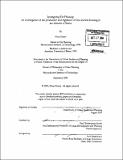Strategizing for housing : an investigation of the production and regulation of low-income housing in the suburgs of Beirut
Author(s)
Fawaz, Mona M., 1972-
DownloadFull printable version (61.84Mb)
Other Contributors
Massachusetts Institute of Technology. Dept. of Urban Studies and Planning.
Advisor
Bishwapriya Sanyal.
Terms of use
Metadata
Show full item recordAbstract
The current consensus in housing policy recognizes the importance of learning from rather than about informal settlements. To serve this end, this dissertation presents a novel methodology for investigating land and housing markets. The methodology consists of investigating time-evolving relationships between attributes of the social agents who intervene on a market (e.g. social standing, religious affiliation, gender), rules-institutions systems (formal and informal institutions), and the macro political-economic context (e.g. price of land, demographic growth). The method was applied to a case study that tracked three groups of actors: developers, public agents, and homeowners, over a fifty-year period (1950-2000) in Hayy el Sellom, a neighborhood located in the southern suburbs of Beirut, Lebanon. The case study relied on in-depth interviews of developers, public agents, and residents, a structured survey of homeowners, research of public archives (e.g. construction and urban regulations, building permits, lot subdivisions), and time series analysis of aerial photographs. The case study demonstrated that the proposed method can unpack the category of the "informal market" by revealing a web of co-existing formal (market and public institutions) and informal (e.g. social, geographic, political associations) institutions whose interplay determined market characteristics (e.g. openness, flexibility, security) and resulted in unequal opportunities for housing and capital accumulation by residents and developers, respectively. Second, the case study unraveled dialectical actor-institution relationships in which one's ability to intervene in the housing market depended on one's ability to tap existing institutions that sustain exchanges and build new ones. Third, the (cont.) study documented the heavy involvement of public agencies or agents in the development of informal regulations and the organization of illegal processes of housing production. Fourth, the case study documented the interconnectedness of housing markets segments, showing how so- called informal markets are directly influenced by city-wide parameters (e.g. price of land, political stability, housing demand) and partially rely on formal market institutions such as banks and contracts. Finally, it was found that greater involvement of formal market institutions did not improve market conditions (e.g. transaction security) or opportunities for capital accumulation.
Description
Thesis (Ph. D.)--Massachusetts Institute of Technology, Dept. of Urban Studies and Planning, 2004. Includes bibliographical references (p. 269-284).
Date issued
2004Department
Massachusetts Institute of Technology. Department of Urban Studies and PlanningPublisher
Massachusetts Institute of Technology
Keywords
Urban Studies and Planning.